Water and wastewater utilities are adapting to the rapidly changing conditions imposed across the country and the world by the COVID-19 pandemic. With stay-at-home orders, closures of schools, restaurants, and other businesses, and major disruptions to the workforce and operations, utilities are changing practices and procedures every day to continue to operate and provide the general public with an essential public service. How will these changing conditions and operations affect utility finances? What are the financial implications of COVID-19 to utilities?
While the current environment continues to rapidly change, it is nearly impossible to comprehensively assess all of the financial implications of COVID-19 to utilities at this time. However, some practices are becoming more commonplace among utilities across the country. This is an attempt to consider financial implications of COVID-19 on utilities on a broad level, and it follows a March 23rd webinar that we conducted with the UNC School of Government. As the weeks go on, utilities should monitor their revenues and expenses to more accurately estimate the financial implications of COVID-19 on their own systems.
Suspension of disconnections due to non-payment
People are being asked or required to stay at home, and handwashing is being emphasized as a critical strategy in containing the spread of the coronavirus. For these two reasons, water utilities across the country have been suspending the practice of cutting off customers due to non-payment. As of March 25, five states and Puerto Rico have imposed statewide moratoriums on water shutoffs and a further 14 states have imposed similar moratoriums on Utilities Commission-regulated water systems (see Food & Water Watch’s spreadsheet). Many utilities are going one step further and are reconnecting previously-disconnected customers.
How utilities handle the associated overdue payments, and fees and penalties for late payments, non-payments, disconnections, and re-connections vary widely. Some utilities are continuing to assess all of the fees on their customers and will attempt to collect those charges over time. Other utilities, such as Detroit, with financial assistance from the State, are offering reduced monthly charges to keep customers connected during the outbreak. Others are waiving fees altogether. The legal authority for utilities to lower or waive fees may vary by State (see blog post for North Carolina).
Any reduction to fees or charges results in loss of revenue to the utility. Our 2017 utility management survey in North Carolina identified that 73 percent of the responding utilities in the state had between 1% and 5% of their customers disconnected from water service due to non-payment. By suspending water shutoffs due to non-payment (a tool used to enforce collections), it is possible that non-payment rates will increase.
Reductions in non-residential water use
Businesses have shut down or reduced operations during this outbreak. Many employees have left their workplaces and are working from home or have reduced hours. Some states and local governments have locked down entire cities or at least certain sectors of businesses such as restaurants and bars. Across the country, water use at commercial (and perhaps some industrial) buildings will decrease significantly under these circumstances.
Non-residential customers represent a large segment of utilities’ customer bases in terms of water use and revenue generation. USGS estimated that, in 2015, 40% of water delivered by public water systems nationwide went to other uses besides residential: this includes commercial, institutional and industrial uses as well as other uses and water losses. Across 277 cities in California in FY2018, businesses and industries accounted for 17% of the water sales revenues generated from residential, business and industrial customers. A portion of those water uses and revenues will decrease while COVID-19 restrictions on businesses continue.
At the local level, reductions in non-residential water use can be even more significant. In North Carolina, one-third of the utilities billed at least a majority of their water volume sales to non-residential customers. It is too early to assess how much non-residential water use will decline for most utilities after only one or two weeks of reduced operations. However, utilities with AMI meters could monitor water use at least daily to make their own estimates more rapidly.
Increased difficulty among residential customers in paying water bills
While non-residential water use will decline, we expect residential water use to increase primarily because more people are staying or working from home. Residential and non-residential water uses – and, in many cases, the rates – are not the same. It is unlikely that water use and revenue losses from the non-residential customers will be exactly offset by increases from the residential customers.
Residential customers will generally use more water, however, and be charged higher bills for their increased consumption. Customers of utilities that charge increasing block rates are more susceptible to even higher increases in their bills if their usage exceeds the block thresholds. At the same time, as businesses close during COVID-19, many people are left without employment or with reduced work hours. As income decreases and water bills increase, more customers will have difficulty in paying their bills as a consequence of COVID-19.
Utilities are recognizing this difficulty and offering to assist customers in various ways. Common methods include extensions to payment deadlines, customized payment plans, level/fixed payment plans, alternative payment methods (and paying the credit card fees on behalf of the customer), and sometimes waiving fees and penalties. Each of these methods have transaction costs for the utilities, but could improve collections.
Customer assistance programs are becoming more common as a tool to financially help individual customers who are unable to pay their water bills. The legal authority of utilities to use their own revenues to fund those programs varies by State, however, and many utilities need to either rely on donations or on a program funded by the local government’s General Fund. At a time when people are facing financial stresses and tax revenues are declining for local governments, attempting to fund such programs may be difficult at this time. There is debate of funding a $1.5 billion national customer assistance program to help low-income households pay their water and wastewater bills, which has been included in the House Bill “Take Responsibility for Workers and Families Act”.
Changes to utility operations and costs
The American Water Works Association surveyed water utilities in the middle of March to assess the impact of COVID-19 on utility operations. By far, the biggest concern at the time was the ability to continue operations while the workforce was going through restrictions. Adjusting work schedules to accommodate social distancing and safety concerns, accommodating absenteeism, and contracting additional operators when needed affects personnel costs for the utility.
There is also the possibility that the availability of personnel protective equipment (PPEs) and chemicals and supplies may become limited if the COVID-19 outbreak continues for a long time, potentially increasing costs. However, in an AWWA webinar on March 20, it was stated that there are currently no supply chain concerns.
Increases to operating costs may be offset by reductions in treatment costs (or other operating costs), depending on whether there are net water use reductions and how the utility manages its personnel and resources.
COVID-19 effects on capital projects and costs may be explored in a separate blog post.
Net financial effects of COVID-19
While the effects on operating costs may be highly localized, it is likely that utility revenues will generally decrease in the short-term. The extent to which this happens will largely depend on how long utilities operate under current COVID-19 condition. If restrictions are lifted in one or two months, and operations return to pre-COVID-19 conditions, the overall financial effects on utilities will not be too significant to overcome with a little time. However, if COVID-19 continues to spread and utilities operate under this new normal for several months, the revenue losses will accumulate and utilities will need strategies to offset the losses.
The National Association of Clean Water Agencies estimates that suspending water shutoffs, restoring connections to delinquent accounts, and reductions in non-residential water use could result in a 20% – or a $12.5 billion – loss in utility revenues across the country. In a separate effort, the United States Conference of Mayors estimated that cities across the United States will need $250 billion in flexible, emergency funding to offset COVID-19 losses to revenues. In their letter, more emphasis was placed on general government functions, although several effects on utility operations were also mentioned. This letter demonstrates that local governments are facing financial stresses beyond those occurring within their water and wastewater funds.
Mitigating financial losses
Water and wastewater utilities have a few tools available to mitigate potential financial losses during COVID-19. In the immediate term, utilities can rely on their reserves to offset revenue losses. A separate blog post will discuss utility reserves in more detail.
Reserves may be sufficient for many utilities in mitigating losses for a short COVID-19 period. However, if the period extends for months, or utilities’ reserves are not sufficiently funded, utilities may have to consider raising rates. Many utilities are currently in their annual budgeting period. Monitoring how revenues and expenses are changing for the utilities in the coming weeks can provide good information to the finance teams in determining whether to adjust the budget for next year to offset losses this year. Of course, raising rates might be difficult to implement if economic conditions worsen overall. Lessons after the Great Recession in various strategies that can make utility finances more resilient can be applicable to utilities concerned about COVID-19 effects on their finances.
Federal financial assistance
Funding programs may be considering adjusting their prioritization for subsidized loans and grants for capital projects in the wake of COVID-19. The Council of Infrastructure Financing Authorities identified measures that could accelerate the disbursement of SRF funding to aid water and wastewater utilities in the aftermath of negative financial implications of COVID-19. Funding programs in your State will announce if/when changes are being implemented.
Late on March 25, the U.S. Senate passed a $2 trillion stimulus bill. The bill, which will be taken up by the House, contains a $150 billion Coronavirus Relief Fund for state, local governments and Tribal governments. These funds are to be distributed proportional to population, and are to be used only to cover necessary expenditures incurred between March 1 and December 30 by the governments due to public health emergencies associated with COVID-19 that were not accounted for in the governments’ budgets (pages 603-604). These funds would be distributed to states, tribes, and to local governments that are municipalities of various forms, counties, and special units of governments that serve more than 500,000 in population. As currently written, it presumably would exclude utilities that are non-governmental, or are special units of government (e.g. Authorities) that do not serve 500,000 people.
Additional COVID-19 relief bills have been introduced and may yet pass into law, providing further funds and directives that affect water and wastewater utilities. For instance, the “Take Responsibility for Workers and Families Act” would fund a $1.5 billion low-income household customer assistance program, and would prohibit water and wastewater disconnections across the country during the COVID-19 emergency.
Resource webpages
COVID-19 conditions are still rapidly changing. Utility operations will likely continue to evolve, creating new financial implications of COVID-19 and other factors. The EFC and many organizations are posting free resources and guidance to utilities on their websites. Our resources (including a free recorded webinar) and links to many organizations’ COVID-19 resources are listed here. We will continue to update the resources on the webpage and in future blog posts.
Thank you!
Utilities are critical in serving the public and ensuring public health and safety. Working together, utilities are supporting one another and strengthening communities during a difficult time. Water and wastewater utility staff have been deemed “essential critical infrastructure workers”. Thank you for your continued public service in the face of COVID-19 risks and implications.



